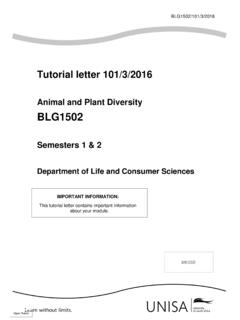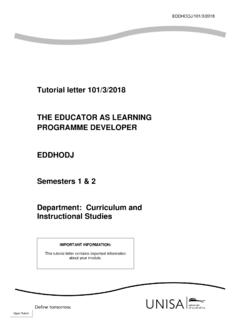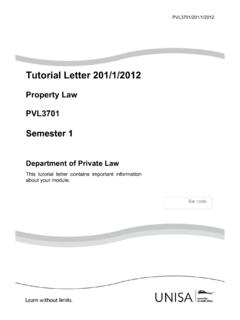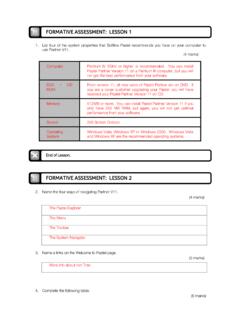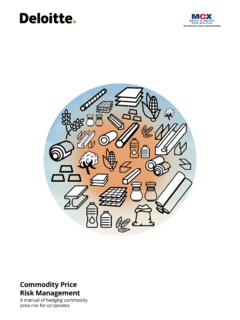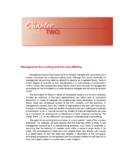Transcription of Multiple choice questions for Introduction Multiple-choice ...
1 Multiple choicequestions for Introduction to Business ManagementMultiple choicequestions for Introduction to Business ManagementSharon Rudansky-Kloppers & Johan StrydomMultiple-choicequestions forIntroductionto Business Management3S O U T H E R N A F R I C A Oxford University Press Southern Africa (Pty) LtdVasco Boulevard, Goodwood, Cape Town, Republic of South AfricaP O Box 12119, N1 City, 7463, Cape Town, Republic of South AfricaOxford University Press Southern Africa (Pty) Ltd is a subsidiary of Oxford University Press, Great Clarendon Street, Oxford OX2 Press, a department of the University of Oxford, furthers the University s objective of excellence in research, scholarship, and education by publishing worldwide inOxford New YorkAuckland Cape Town Dar es Salaam Hong Kong Karachi Kuala Lumpur Madrid Melbourne Mexico City NairobiNew Delhi Shanghai Taipei TorontoWith offices inArgentina Austria Brazil Chile Czech Republic France GreeceGuatemala Hungary Italy Japan Poland Portugal Singapore South Korea Switzerland Turkey Ukraine VietnamOxford is a registered trade mark of Oxford University Pressin the UK and in certain other countriesPublished in South Africaby Oxford University Press Southern Africa (Pty)
2 Ltd, Cape TownMultiple- choice questions for Introduction to Business ManagementISBN 978 019 905040 6 Oxford University Press Southern Africa (Pty) Ltd 2010 The moral rights of the author have been assertedDatabase right Oxford University Press Southern Africa (Pty) Ltd (maker)First published 2010 All rights reserved. No part of this publication may be reproduced,stored in a retrieval system, or transmitted, in any form or by any means,without the prior permission in writing of Oxford University Press Southern Africa (Pty) Ltd,or as expressly permitted by law, or under terms agreed with the appropriatedesignated reprographics rights organization. Enquiries concerning reproductionoutside the scope of the above should be sent to the Rights Department,Oxford University Press Southern Africa (Pty) Ltd, at the address must not circulate this book in any other binding or coverand you must impose this same condition on any editor: Alida TerblancheEditor: Nicola van RhynDesigner: Jade BenjaminCover designer: Samantha RowlesSet in 10 pt on 12 pt Photina by Elbert VisserPrinted and bound by ABC Press, Kinghall Avenue, Epping Industria 2, Cape TownAcknowledgementsThe authors and publisher gratefully acknowledge permission to reproduce copyright material in this book.
3 Every effort has been made to trace copyright holders, but if any copyright infringements have been made, the publisher would be grateful for information that would enable any omissions or errors to be corrected in subsequent to Multiple - choice questions for Introduction to Business Management Johan Strydom & Sharon Rudansky-Kloppers Oxford University Press Southern Africa (Pty) Ltd 2010 1 Chapter 1 questions Solution Explanation 1 4 The task of business management relates to the economic principle, namely to achieve the highest possible satisfaction of needs with scarce resources. More specifically, it entails an examination of factors, methods and principles that enable a business to function as efficiently and productively as possible in order to maximise its profits.
4 2 4 The question concerns the definition of the economic principle. The economic principle can be broadly defined as the achievement of the highest possible satisfaction of needs by means of scarce resources. In other words, it has to do with obtaining maximum output from existing scarce inputs. Statement 4 is therefore correct. Defining the economic principle in any other way would be wrong. This means that the other statements in the question are wrong. 3 4 Since there is no economic advantage to working harder, socialistic systems provide no inherent incentive to participate. Not more so than in state organisations. Typically health care and education starts to become unproductive.
5 4 3 The state or government keeps its interference in the system to a minimum. The government s role is limited to providing legislation to protect businesses and consumers and making sure no single business or organisation restricts competition. It also provides essential services (like police and defence) and ensures the country s money supply is stable. 5 4 Public relations are seen as a functional area within a business. The public relations function relates to the creation of a favourable and objective image of the business. Public relations must promote good relations and goodwill between the business and the external groups and other businesses that are directly and indirectly involved in the business.
6 6 3 In a free market system most products and services are supplied by private organisations and individuals seeking profits in return for the productive investment and utilisation of their assets and capital. Therefore the driving force behind entrepreneurs and their businesses in a free market is profit. Therefore statement (a) is correct. In a command economy, individuals cannot own land, factories and equipment as the state owns and controls the community s resources or factors of production. Therefore statement (b) is incorrect. Under both the free-market system and socialism the state intervenes to help solve the economic problems and stabilise economic fluctuations.
7 Therefore statement c is correct. Within the free-market economy, the economic environment is Solutions to Multiple - choice questions for Introduction to Business Management Johan Strydom & Sharon Rudansky-Kloppers Oxford University Press Southern Africa (Pty) Ltd 2010 2 questions Solution Explanation unstable, and so statement (d) is also correct. 7 3 Option 1 is incorrect because only in a free-market economy are farmers, factory owners, industrialists and individuals free to do what they like with their assets. Option 2 is incorrect. Socialism may be regarded as a compromise between a pure market economy and a pure command economy. Because the socialist system is a compromise, the state does not own and control all the businesses, as in a command economy, but only those undertakings which have strategic value, such as those concerned with fuel or energy and mass transport.
8 Less important and smaller matters such as trade and construction, and the production of materials and services of lesser strategic importance, are left to private initiative. Option 3 is correct because in a socialistic system the state does own and control many of the country s principle industries such as transportation, health services and energy. Option 4 is incorrect because minimum state interference in markets is a characteristic of a free-market economy and not socialism. 8 1 Within socialism, the state controls general key industries, such as transportation and communication. Option 2 is incorrect, as the state keeps its interference in the system to a minimum, but is not entirely excluded from activity.
9 The state ensures the proper maintenance of the system without excessive regulation of the business world. Option 3 is incorrect. Due to the limited impact of the state, and the free competition that exists in the free-market economy, it might occur that business organisations exploit the consumer for the ultimate drive in profit. Option 4 is incorrect. The statement belongs to the command economy and not socialism. 9 2 Capital includes buildings, machinery, computers and cash registers that are not for human consumption, but rather used for making further production of final consumer products possible. Capital products usually have a long working life.
10 The cash register and building are capital items. 10 3 The only correct description befits option 3, as the boxes and ribbons used by Nomsa are production factors and contribute towards the final product. Production factors are basic inputs in the production of products and services. 11 2 If there is more involvement from the state in a free market economy, it does not indicate a move towards a command Solutions to Multiple - choice questions for Introduction to Business Management Johan Strydom & Sharon Rudansky-Kloppers Oxford University Press Southern Africa (Pty) Ltd 2010 3 questions Solution Explanation economy or centrally controlled economy.
